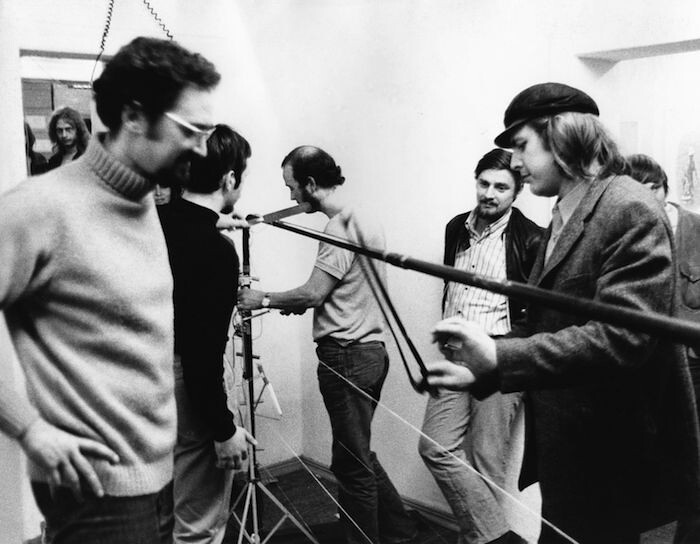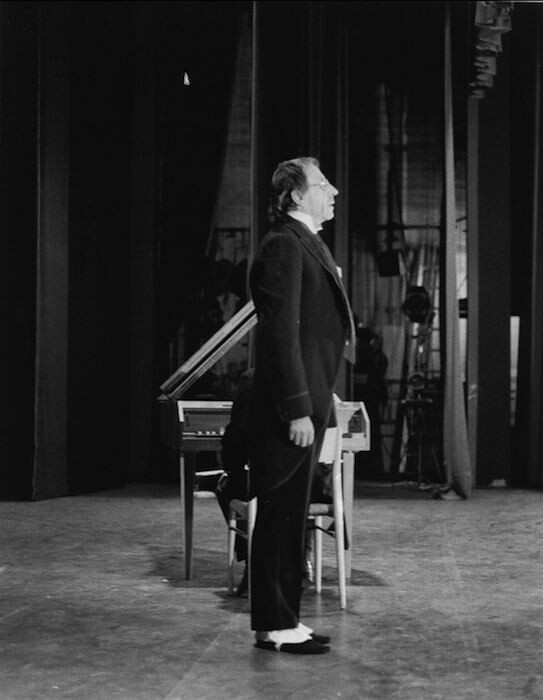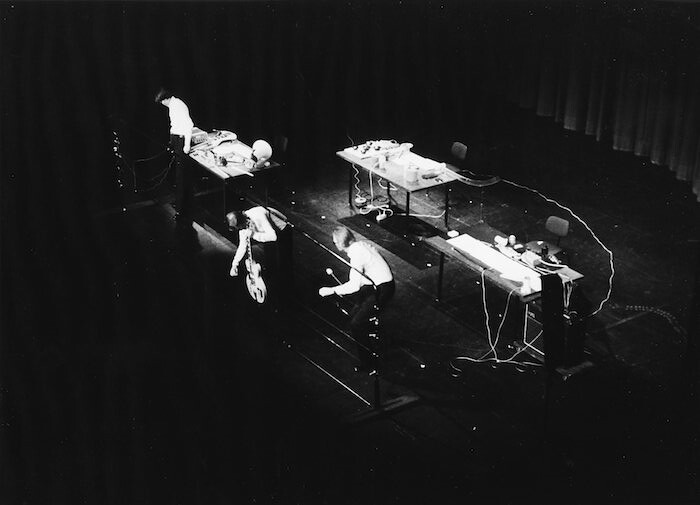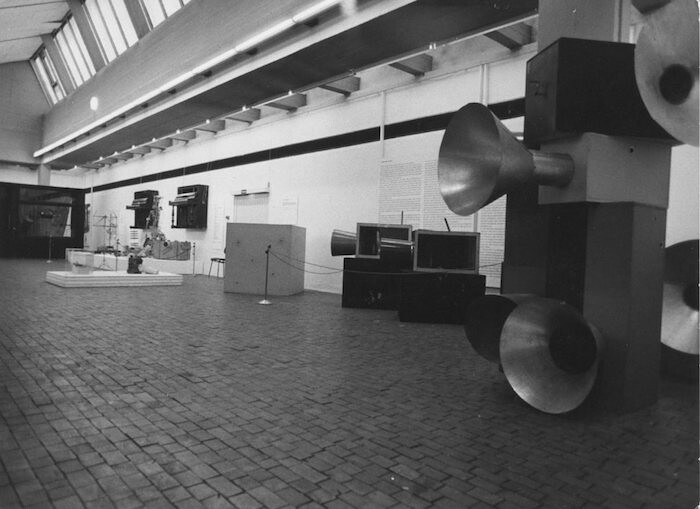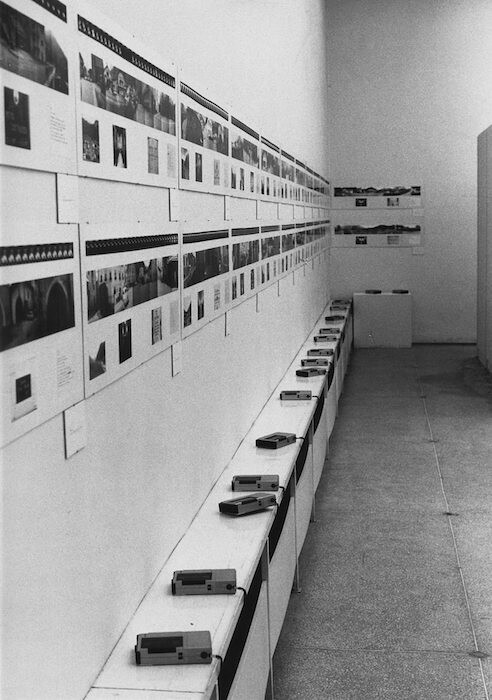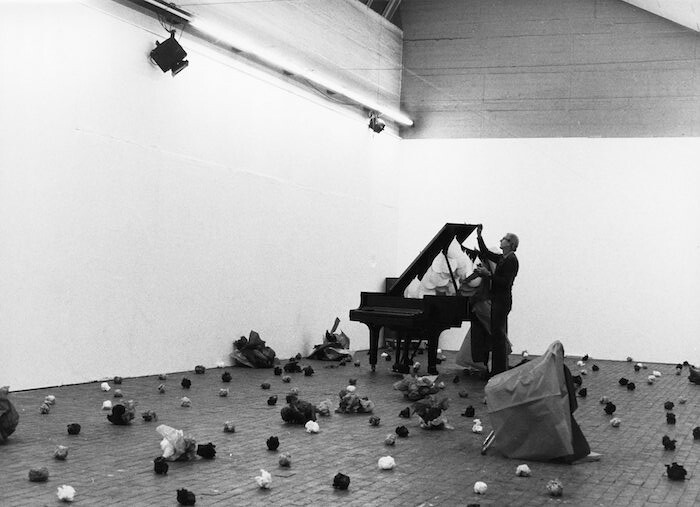In tandem with “Ich kenne kein Weekend. Archive and Collection René Block,” a double-venue exhibition recognizing the work of gallerist, curator and collector René Block organized in Berlin this autumn, art-agenda presents a three-part feature on Block. Part I and II consist of an interview led by Luca Cerizza, while Part III is an introduction to the current Berlin exhibitions, written by Eva Scharrer. Part I is available here, Part II follows, and Part III will be published on December 22, 2015.
4) Mauricio Kagel (September 18, 1970, Galerie Block, Berlin)
Luca Cerizza: As “Musikfestival” had already demonstrated, your interest in experimental music exceeded Fluxus. In the same year, 1966, you organized the second ever and the first European execution of Vexations by Eric Satie (disputably composed in 1893), legendarily known to be the longest piece of music ever written, based as it is on the repetition of a single page of music 840 times. In the same year, you invited the free-jazz extremist Peter Brötzmann and his trio, who were, at the time, still unknown; in 1968, Tangerine Dream performed with Bernhard Höke; while in 1970, you invited the composer Mauricio Kagel to conceive an installation for Galerie Block, as part of the series “Akustische Räume.” Can you recollect what the installation consisted of? And how did you generally approach the space of the gallery for sound and music acts?
René Block: 1970 was the year dedicated to acoustic installations in my gallery. Just as sound became a more and more important extensive element for visual artists, some composers applied visual elements and space to extend their oeuvre. Kagel especially played a central role here. He constructed a “harp” that crossed the room diagonally and whose wire strings were amplified electronically. The audience was invited to play the instrument and generate sounds from it. Besides Paik and Wolf Vostell, other visual artists such as K.H. Hödicke, Markus Raetz, and H.J. Dietrich, the performance artist Conrad Schnitzler, and Kagel were invited.
5) Flux-Harpsichord Konzert (September 3, 1976, Akademie der Künste, Berlin)
LC: You invited Fluxus’s musical iconoclasts to perform on a traditional and elegant instrument: the harpsichord. How did this idea come about? What was the result of this strange encounter?
RB: For the exhibition New York, Downtown Manhattan – SoHo [an exhibition Block curated in 1976 as a collaborative project of the Akademie der Künste and the Berliner Festspiele], I had invited George Maciunas, the central figure of the Fluxus movement, to construct a Fluxus-Labyrinth (1976). Through this project, other New York-based Fluxus artists such as Robert Watts, Yoshi Wada, Larry Miller, and Nam June Paik came to Berlin. This led to the idea to also invite some of the important artists living in Europe—George Brecht, Ben Vautier, Robert Filliou, Joe Jones—and to ask Maciunas, who had organized the concerts in 1962 in Wiesbaden, to become active one more time in Europe. The center of the event was the harpsichord, the classical instrument on which and with which some of the classical Fluxus compositions had been performed. But some new works had also been written for it. With the constellation of artists involved—which had never before existed in this peculiar cast—the evening in the concert hall of the Akademie der Künste became the last authentic highlight of Fluxus music, and the last concert that Maciunas organized and directed himself.
6) Joseph Beuys & Nam June Paik, In Memoriam George Maciunas (July 7, 1978, Kunstakademie, Düsseldorf)
LC: This is another example of the way your gallery operated, organizing and promoting events in different locations, putting you more in the role of a curator than a gallerist, I would say. This homage to Maciunas, who had died the same year, was performed at the art academy in Düsseldorf, where Beuys had been a professor through the 1960s. Was the homage your idea? What is your memory of George Maciunas and your opinion of his role in Fluxus?
RB: Maciunas, architect and designer, promoter and chairman of the early Fluxus movement, and co-founder of Jonas Mekas’s Anthology Film Archives, was an extremely active character. He was also the inventor and founder of the co-op system in SoHo, through which artists joined and together bought loft buildings in downtown Manhattan in the early 1970s, when they were still affordable. Since the mid 70s, he had withdrawn more and more and planned a big artists’ colony in the countryside in Massachusetts, which followed the same principle as in SoHo, but more in the spirit of Worpswede. But before he could realize his idea, he died in 1978. It was Nam June Paik who asked me to organize an event in his memory. It should take place in the art academy in Düsseldorf, where Maciunas and Beuys had already organized a Fluxus event in 1963. So it was an obvious choice to organize a piano duet with Beuys and Paik there. The concert was performed on two opposing pianos and lasted—reversing the number of years that Maciunas lived—exactly 74 minutes. It is one of the few Fluxus events that has been documented in full on video and vinyl.
7) Für Augen und Ohren (1980, Akademie der Künste, Berlin; Musée d’art moderne de la ville de Paris)
LC: Galerie Block closed in 1979, after a brief, two-year tenure in New York. The following year, you organized a large exhibition on the mutual relationship between music and visual arts, “from the music box to the acoustic environment,” as the subtitle of the exhibition declared. The show opened in Berlin and travelled to Paris, accompanied by an extensive catalogue. In retrospect it could be said that 1979 seems a rather symbolic year to close the gallery. It was a moment when the Western world was facing political and cultural change, and the 1960s and 70s avant-gardes were in decline while, at the same time, many of the artists you presented early on had become more established (Joseph Beuys is just one example). It seems equally symbolic that an exhibition about music and visual arts was your first project after the gallery closed. Bringing your interest in and knowledge of music into the museum seems like a natural progression. The exhibition was addressed to the eyes and ears of a new generation, one whose interests were formed by your gallery’s anticipatory music programming. After years of general disinterest in and skepticism about avant-garde music from audiences in Berlin, this show was a huge success.
RB: Für Augen und Ohren was realized as a collaborative project of the Akademie der Künste with Berliner Festspiele and took place, just like New York, Downtown Manhattan – SoHo four years earlier, in the exhibition halls of the academy. The availability of the academy’s concert hall was, however, crucial for the extensive programs accompanying both exhibitions. With both partners, we had experienced and well-functioning professionals on our side. Of course, the contemporary interdisciplinary modes of expression of artists and composers were both the point of departure and the main concern of the project. But through my research trips prior to the exhibition, I encountered, discovered, and rediscovered many forgotten pioneers—especially those who experimented in the microtonal field and had invented or built new instruments—who became essential for the concert program. For me, this project became an exciting expedition through the twentieth century.
Through my own work, I was familiar with the developments in sound art since the 1900s. Besides working with artists of the Fluxus movement, I had strong connections to other “outsiders,” especially to a new generation of artists and composers, such as Terry Fox, Sarkis, Bernhard Leitner, Christina Kubisch, Bill Fontana, Laurie Anderson, Conny Beckley, or Rolf Julius. From this perspective, I wanted to include the “fathers”—I would name Cage, David Tudor, and Earle Brown as such—and the grandfathers Marcel Duchamp, Luigi Russolo, Erik Satie, Charles Ives, Harry Parch, Percy Grainger, or Ivan Wyschnegradsky in the project—that is, the exhibition as well as the program of concerts, which were very important to me. We succeeded in bringing over the fantastical new musical instruments that Partch built in the 1930s for his 34-sound-system from California to Germany for the first time, and organized a performance of one of his operas based on “hobo” poetry. Another sensation was the investigations, designs, and calculations of the Russian Futurist composer Ivan Wyschnegradsky, which translated his quarter-tone-system into colored domes that emerged parallel to the music. During his 20-year-long research, he executed 100 amazingly beautiful drawings. But the historically key moment was probably 1913, when Russolo published his manifesto “L’arte dei rumori” [The Art of Noises] and built his intonarumori [noise makers], giving music a new direction, and when Duchamp anticipated Fluxus ideas with his aleatory composition Erratum musical.
These compositions suggested a conceptual and performative music, as envisioned also by Satie. In his wonderful composition Musique d’ameublement [Furniture Music, 1917], the music is meant to become a fixed part of the room like a piece of furniture. When it premiered in 1917, three groups of eight musicians each had to play the three pieces of music (that were written especially by Satie) for as long as possible—that is, for several hours. In 1980, however, modern technology allowed for a brilliant yet poetic solution. We had prerecorded the three compositions, which were played in infinite loops. The room was furnished like a salon, with tapestry, armchairs, and a palm tree. Speakers were placed in different positions in the room, hidden under the tapestry, und thus the music became a permanent part of the environment—just like furniture. I think this exhibition was a kind of a summary of my early years in Berlin. It was received enthusiastically by the public and was luckily quite well documented through various reports on television.
My gratitude and thanks to Eva Scharrer for her generous help in the research phase of this article.

